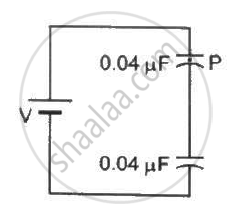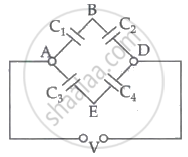Advertisements
Advertisements
Question
A positively charged particle is released from rest in a uniform electric field. The electric potential energy of the charge ______.
Options
remains a constant because the electric field is uniform
increases because the charge moves along the electric field
decreases because the charge moves along the electric field
decreases because the charge moves opposite to the electric field
Solution
A positively charged particle is released from rest in a uniform electric field. The electric potential energy of the charge decreases because the charge moves along the electric field.
Explanation:
Electric potential decreases in the direction of electric field. The direction of electric field is always perpendicular to one equipotential surface maintained at the high electrostatic potential to another equipotential surface maintained at low electrostatic potential.
The positively charged particle experiences electrostatic force along the direction of electric field and hence moves in the direction of electric field. Thus, positive work is done by the electric field on the charge. We know
`W_("electrical") = -ΔU = -qΔV = q(V_("initial") – V_("final"))`
Hence electrostatic potential energy of the positive charge decreases.
APPEARS IN
RELATED QUESTIONS
A point charge +Q is placed at point O, as shown in the figure. Is the potential difference VA – VB positive, negative or zero?

The particle P shown in figure has a mass of 10 mg and a charge of −0⋅01 µC. Each plate has a surface area 100 cm2 on one side. What potential difference V should be applied to the combination to hold the particle P in equilibrium?

Answer the following question.
The magnitude of the electric field (in NC – 1) in a region varies with the distance r(in m) as
E = 10r + 5
By how much does the electric potential increase in moving from point at r = 11 m to a point at r = 10 m.
Electric potential energy of two point charges q and q0 is ________.
A cube of metal is given a positive charge Q. For this system, which of the following statements is true?
-
The metal plate divides the capacitor into two capacitors connected in parallel to each other.
-
The metal plate divides the capacitors into two capacitors connected in series with each other.
-
The metal plate is equivalent to a dielectric of zero dielectric constant.
An electric dipole of moment `vec"p"` is placed in a uniform electric field `vec"E"`. Then ______.
- the torque on the dipole is `vec"p" xx vex"E"`
- the potential energy of the system is `vec"p" * vec"E"`
- the resultant force on the dipole is zero.
Choose the correct option.
If a conductor has a potential V ≠ 0 and there are no charges anywhere else outside, then ______.
- there must be charges on the surface or inside itself.
- there cannot be any charge in the body of the conductor.
- there must be charges only on the surface.
- there must be charges inside the surface.
The electric potential on the axis of an electric dipole at a distance ‘r from it’s centre is V. Then the potential at a point at the same distance on its equatorial line will be ______.
The potential difference between points B and E of the circuits is ______.

